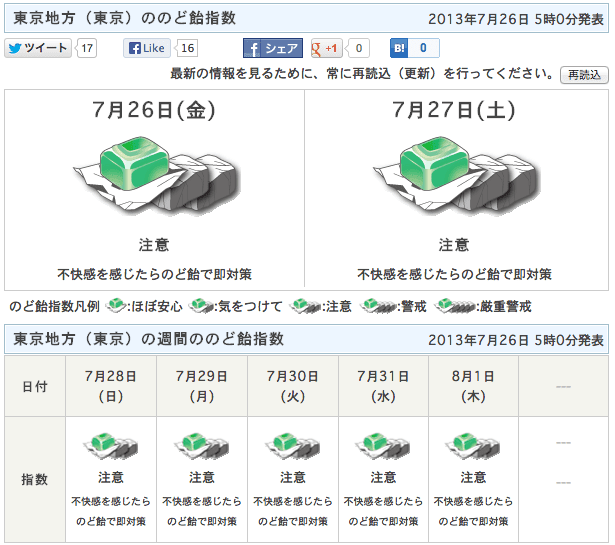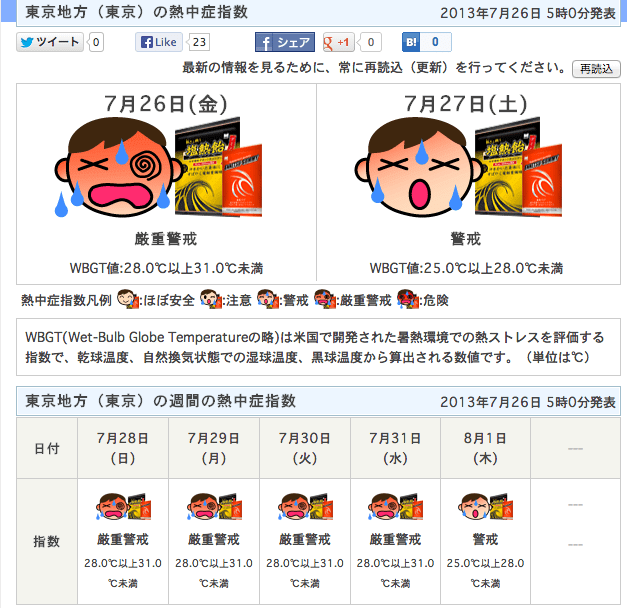Japan Weather Report: Cloudy With A Chance Of…Ice Cream?
You’re familiar with a weather forecast and the UV index, but have you ever heard of a cockroach forecast? Or an ice cream index?
The Japan Weather Association not only provides a typical weather forecast (天気予報, てんきよほう) but a variety of indexes and reports, called 指数 (しすう) in Japanese, such as how long it takes to dry your clothes outside, whether you should take cough drops, and how to know if you should eat ice cream on any given day. The temperature in Japan is only one part of the forecast you need!
Laundry – 洗濯 (せんたく)
In Japan people don’t typically own clothes drying machines, so it’s common to see clothes, towels, and blankets hanging outside to dry. And while it’s obvious you don’t want to hang your clothes out on a rainy day, some days will result in slower drying times. The higher the index number and the “drier” the shirt, the faster your items will dry.
Going Out – お出かけ (おでかけ)
Should you go out today? The “odekake” index tells you if it is a good idea or not. Four or five hats means you should go, while one hat tells you that it’s better to hang around at home. http://season.tenki.jp/season/indexes/odekake/

Cough Drop – のど飴 (のどあめ)
Despite the high humidity throughout most of Japan all summer, your throat might become dry depending on the day, which means time for some…cough drops? Yes, the cough drop index tells you when you should start taking measures to relieve a scratchy throat. You don’t need to worry if you only see one lozenge, but two instructs you to have some on hand. If three or more are listed your throat is in “danger”.

Other indexes include garments (服装, ふくそう), starry sky (星空, ほしぞら), umbrella (傘, かさ), UV index (紫外線, しがいせん), real-feel temperature (体感温度, たいかんおんど), car wash (洗車, せんしゃ), and leisure (レジャー).
Summer Weather Indexes
While some of the indexes are available year-round, seasonal indexes change in the Spring and Fall. Some of the Summer indexes below might surprise you.
Heat Stroke – 熱中症 (ねっちゅうしょう)
This is an important index given how hot summer days can get and deaths do occur each year in Japan when the temperatures shoot up. The more red and crazy the person looks, the higher the chance of heatstroke.

Sweat – 汗かき (あせかき)
Summers in Japan are humid, unless you’re in Hokkaido, so expect to sweat outside (and subsequently freeze when walking into a strongly air-conditioned building). The more sweat drops the person shows, the more likely you are to perspire. This is why people carry around a sweat towel or hand towel, which also come in handy after washing hands.

Cooling – 冷房 (れいぼう)
Although you probably know when you need to turn on a fan or the air conditioning, the cooling index lets you know whether you need to turn on the エアコン (air conditioner). Open a window if the index shows one fan, and quickly find an air conditioned place if you see four or five.

Ice Cream – アイス
Who doesn’t want a weather agency telling you ice cream is in the forecast? The more cones you see, the more strongly they recommend you get yourself some アイス. If it’s really hot, with an index of 90 or more, they specifically suggest eating some kakigori (shaved ice with flavored syrup). But when isn’t ice cream worth eating?

Beer – ビール
Similar to ice cream, the more glasses of brew you see, the more they recommend throwing back a cold one.

In October the summer seasonal indexes will switch to winter ones, which include 素肌乾燥 (dry skin), 風邪ひき (how likely to catch a cold), 掛け布団 (comforters), 暖房 (heating), and 鍋もの (hot food), among others.
And every year in early spring, they publish an official cherry blossom forecast for all the folks eagerly awaiting the arrival of spring and the chance to do hanami, cherry blossom viewing, often involving a picnic with friends.
All screenshots and information above translated from the Japan Weather Association website.
Cockroach Forecast – ゴキブリ天気予報
And finally, to make sure you’re prepared for all that a Japanese summer brings, the site Gokiten gives you a chance to check the cockroach forecast to see how likely it is that you’ll see one of these unpleasant surprises. The forecast is based on temperature and humidity, but users can submit reports of when and how many cockroaches they’ve seen.

